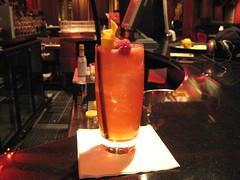Ten: Winter's End
11:44am on March 20 2009 marks the Vernal Equinox, one of the two points of the year at which the Sun is directly over the Earth's equator. Or the Earth's equator is directly over the Sun, if you want to be picky about it. See, astronomy lessons and everything. The Vernal Equinox marks the end of winter and the start of spring, unless you happen to be in the Southern Hemisphere, in which case it's the end of summer and the start of winter. If you are south of the Equator, I'm so sorry. You've got...ooh, 186 days until this post becomes topical.
And so spring is coming like a badly-driven haulage truck on an icy road, which is cause for much celebration in Northern Europe. Perhaps this will be the year when spring is accompanied with temperatures north of 20°C and bikinis for everyone, but I think that's unlikely. It doesn't mean the occasion shouldn't be marked with some kind of mixed drink.
Winter's End
40ml Amsterdamsche Oude Genever
10ml St. Germain
15ml Noilly Prat Dry
Stir all ingredients with ice and strain into a chilled martini glass. Garnish with a single mint leaf.






